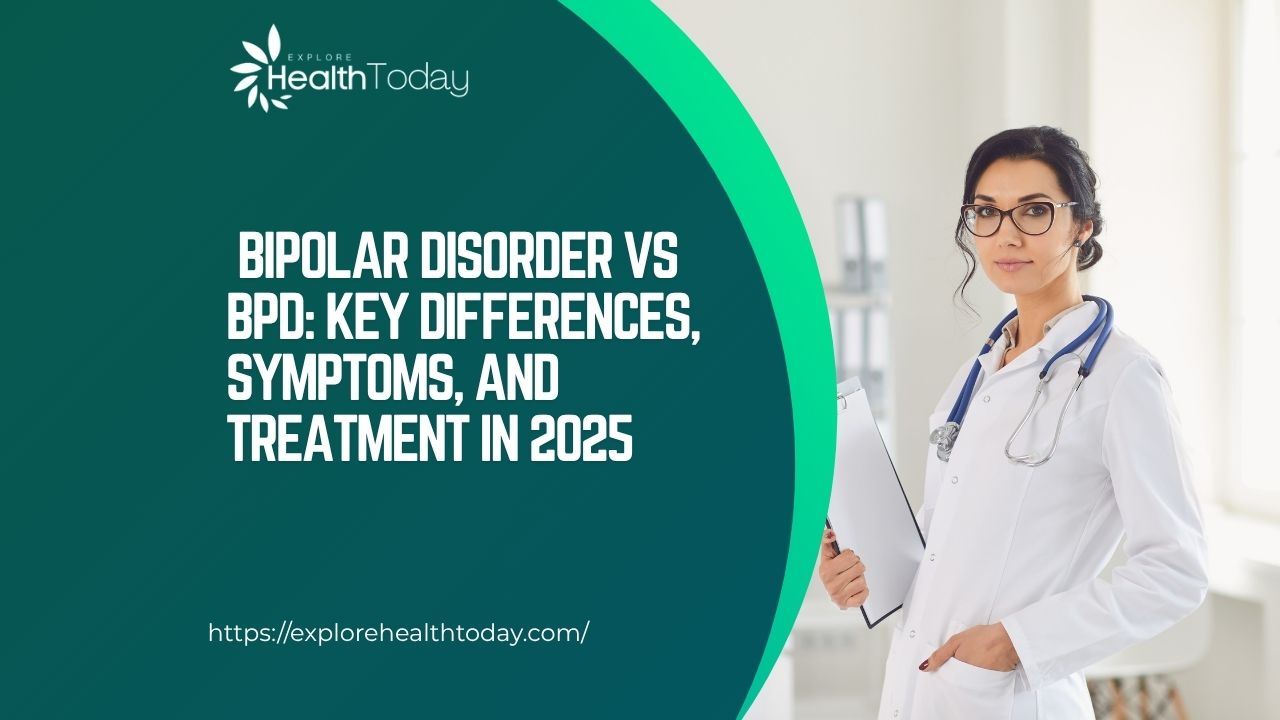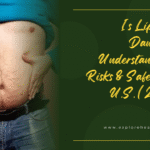Mental health conditions often overlap in symptoms, making accurate diagnosis and treatment a challenge. Two commonly confused disorders are bipolar disorder and borderline personality disorder (BPD). Though both involve mood instability and intense emotional responses, they are distinct conditions with different causes, symptoms, and treatments.
In this comprehensive guide, we’ll break down the key differences between bipolar disorder vs BPD, how each is diagnosed and treated in 2025, and what patients and families in the U.S. need to know about navigating the mental health system.
Understanding the Basics
What Is Bipolar Disorder?
Bipolar disorder is a mood disorder characterized by episodes of mania (high energy, euphoria, or irritability) and depression (low energy, sadness, hopelessness). These mood shifts typically last for days to weeks and are often unrelated to external circumstances.
There are several types:
- Bipolar I: At least one full manic episode (often followed by depressive episodes)
- Bipolar II: At least one hypomanic episode and one major depressive episode
- Cyclothymic Disorder: Milder symptoms that cycle over a period of two years or more
According to the National Institute of Mental Health (NIMH), about 2.8% of U.S. adults had bipolar disorder in the past year (2023 data).
What Is BPD?
Borderline Personality Disorder (BPD) is a personality disorder characterized by ongoing patterns of unstable relationships, intense emotions, fear of abandonment, impulsivity, and a distorted self-image.
People with BPD may experience:
- Emotional dysregulation
- Rapid mood swings (often triggered by interpersonal conflict)
- Self-harming behaviors
- Suicidal thoughts or actions
- Chronic feelings of emptiness
According to the National Education Alliance for Borderline Personality Disorder (NEABPD), BPD affects 1.4% of adults in the United States, but is often underdiagnosed or misdiagnosed.
Bipolar Disorder vs BPD: Key Differences
| Feature | Bipolar Disorder | Borderline Personality Disorder (BPD) |
| Type of Disorder | Mood disorder | Personality disorder |
| Mood Changes | Last for days to weeks | Rapid, often hours to a day |
| Triggers | Often no external trigger | Triggered by relationships or stressors |
| Mania/Hypomania | Present (elevated mood, grandiosity) | Not typical |
| Depression | Common in both | Common, but less cyclical |
| Self-Harm/Suicidal Behavior | May occur during depressive episodes | More frequent, often in response to emotional pain |
| Impulsivity | Episodic | Chronic |
| Treatment Response | Typically medication and therapy | Therapy is primary, medication used as needed |
Shared Symptoms and Diagnostic Challenges
Bipolar disorder and BPD share overlapping symptoms:
- Mood instability
- Impulsivity
- Irritability
- Depression
- Risky behavior
Because of these overlaps, misdiagnosis is common. In fact, a 2024 U.S. mental health study published in Psychiatric Services found that nearly 40% of individuals with BPD were initially misdiagnosed with bipolar disorder, often delaying effective treatment.
Why It Matters:
A misdiagnosis can lead to ineffective treatment plans, including medications that may not work or may worsen symptoms in patients with BPD.
Diagnosing in 2025: Improvements and Tools
In 2025, mental health professionals rely on a combination of:
- Clinical interviews
- Patient history
- Standardized assessments like the SCID-5-PD for personality disorders
- Mood charting apps for tracking episodes
The DSM-5-TR continues to serve as the gold standard for mental health diagnoses, though recent policy shifts are pushing for more integrated care models that involve both psychiatric and psychological assessments before reaching a diagnosis.
Some clinics are also incorporating AI-assisted screening tools to flag potential diagnostic errors and track emotional instability patterns over time.
Treatment for Bipolar Disorder
Medications
- Mood stabilizers: Lithium (still a top choice in 2025), valproate
- Antipsychotics: Quetiapine, lurasidone
- Antidepressants (with caution): Only in combination with mood stabilizers
Psychotherapy
- Cognitive Behavioral Therapy (CBT)
- Psychoeducation for managing triggers and adherence to treatment
- Family-focused therapy for support
Treatment for BPD
Primary Approach: Psychotherapy
- Dialectical Behavior Therapy (DBT): Considered the gold standard for BPD. Teaches mindfulness, distress tolerance, emotional regulation, and interpersonal effectiveness.
- Mentalization-Based Therapy (MBT): Helps individuals understand their emotions and others’ mental states.
- Transference-Focused Psychotherapy (TFP): Focuses on understanding the root of emotional conflicts.
Medications
While no medications are FDA-approved specifically for BPD, certain symptoms may be treated with:
- Antidepressants (SSRIs)
- Mood stabilizers
- Antipsychotics
However, medications are used cautiously and sparingly, as they are not a primary treatment for BPD.
Co-occurrence: Can Someone Have Both?
Yes. It is possible—and not uncommon—for a person to be diagnosed with both bipolar disorder and BPD. In these cases, treatment must be carefully tailored, often involving:
- Dual diagnosis expertise
- Coordinated psychiatric and therapeutic care
- Close monitoring of medication effects
Impact on Daily Life
Both conditions can interfere with:
- Career and academic performance
- Personal relationships
- Financial stability
- Physical health (due to medication side effects or self-neglect)
U.S. workplace accommodations in 2025 under the Americans with Disabilities Act (ADA) allow employees to request:
- Flexible scheduling for appointments
- Mental health days
- Reduced workload during mood episodes
Mental health awareness in workplaces has grown, with many HR departments offering Employee Assistance Programs (EAPs) that include therapy and counseling.
Mental Health in the U.S. (2024–2025): The Bigger Picture
The U.S. is facing a mental health crisis—particularly among young adults and marginalized populations. According to the CDC, mental health-related ER visits rose by 18% in 2024, with mood disorders and personality disorders among the top causes.
To combat this:
- States like California, New York, and Illinois have launched telehealth expansions.
- The Mental Health Parity and Addiction Equity Act continues to ensure that insurance plans cover mental health services at the same level as physical health.
- The 988 Suicide & Crisis Lifeline, launched nationwide in 2022, continues to provide immediate support to those in crisis.
What to Do If You’re Struggling
If you or someone you know is experiencing symptoms of either disorder, consider the following steps:
- Talk to your primary care provider for a referral
- Schedule an evaluation with a psychiatrist or licensed therapist
- Track your moods daily using a mental health app
- Join a support group through organizations like NAMI or Mental Health America
Conclusion
Understanding the differences between bipolar disorder vs BPD is critical for getting the right help. While they may share some surface-level symptoms, the underlying causes, patterns, and treatments are distinct. Accurate diagnosis and personalized care can dramatically improve outcomes for both conditions.
With growing mental health awareness and more sophisticated tools in 2025, Americans have more resources than ever to seek diagnosis, treatment, and support.
If you suspect you or someone close may be experiencing symptoms of bipolar disorder or BPD, don’t wait. Reach out to a mental health professional for a comprehensive evaluation. Early intervention and the right treatment can change the trajectory of your life.
About ExploreHealthToday.com
ExploreHealthToday.com was created to be a one-stop resource where readers can find up-to-date, well-researched articles on a variety of health topics. From nutrition and wellness to lifestyle and mental health, we strive to provide reliable information to help you make informed decisions about your well-being.
We believe that good health starts with good information, and our mission is to empower our readers with knowledge they can trust.
Visit us at ExploreHealthToday.com to learn more.





